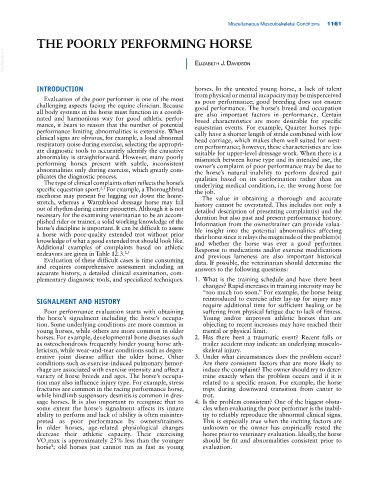Page 1195 - Adams and Stashak's Lameness in Horses, 7th Edition
P. 1195
Miscellaneous Musculoskeletal Conditions 1161
THE POORLY PERFORMING HORSE
VetBooks.ir elizabeth J. DaviDSon
INTRODUCTION horses. In the untested young horse, a lack of talent
from physical or mental incapacity may be misperceived
Evaluation of the poor performer is one of the most as poor performance; good breeding does not ensure
challenging aspects facing the equine clinician. Because good performance. The horse’s breed and occupation
all body systems in the horse must function in a coordi are also important factors in performance. Certain
nated and harmonious way for good athletic perfor breed characteristics are more desirable for specific
mance, it bears to reason that the number of potential equestrian events. For example, Quarter horses typi
performance limiting abnormalities is extensive. When cally have a shorter length of stride combined with low
clinical signs are obvious, for example, a loud abnormal head carriage, which makes them well suited for west
respiratory noise during exercise, selecting the appropri ern performance; however, these characteristics are less
ate diagnostic tools to accurately identify the causative suitable for upper‐level dressage work. When there is a
abnormality is straightforward. However, many poorly mismatch between horse type and its intended use, the
performing horses present with subtle, inconsistent owner’s complaint of poor performance may be due to
abnormalities only during exercise, which greatly com the horse’s natural inability to perform desired gait
plicates the diagnostic process. qualities based on its conformation rather than an
The type of clinical complaints often reflects the horse’s underlying medical condition, i.e. the wrong horse for
specific equestrian sport. For example, a Thoroughbred the job.
2,3
racehorse may present for lugging out down the home The value in obtaining a thorough and accurate
stretch, whereas a Warmblood dressage horse may fall history cannot be overstated. This includes not only a
out of rhythm during canter pirouettes. Although it is not detailed description of presenting complaint(s) and the
necessary for the examining veterinarian to be an accom duration but also past and present performance history.
plished rider or trainer, a solid working knowledge of the Information from the owner/trainer can provide valua
horse’s discipline is important. It can be difficult to assess ble insight into the potential abnormalities affecting
a horse with poor‐quality extended trot without prior their horse since it relays the magnitude of the problem(s)
knowledge of what a good extended trot should look like. and whether the horse was ever a good performer.
Additional examples of complaints based on athletic Response to medications and/or exercise modifications
endeavors are given in Table 12.3. 2,3 and previous lameness are also important historical
Evaluation of these difficult cases is time consuming data. If possible, the veterinarian should determine the
and requires comprehensive assessment including an answers to the following questions:
accurate history, a detailed clinical examination, com
plementary diagnostic tools, and specialized techniques. 1. What is the training schedule and have there been
changes? Rapid increases in training intensity may be
“too much too soon.” For example, the horse being
SIGNALMENT AND HISTORY reintroduced to exercise after lay‐up for injury may
require additional time for sufficient healing or be
Poor performance evaluation starts with obtaining suffering from physical fatigue due to lack of fitness.
the horse’s signalment including the horse’s occupa Young and/or unproven athletic horses that are
tion. Some underlying conditions are more common in objecting to recent increases may have reached their
young horses, while others are more common in older mental or physical limit.
horses. For example, developmental bone diseases such 2. Has there been a traumatic event? Recent falls or
as osteochondrosis frequently hinder young horse ath trailer accident may indicate an underlying musculo
leticism, while wear‐and‐tear conditions such as degen skeletal injury.
erative joint disease afflict the older horse. Other 3. Under what circumstances does the problem occur?
conditions such as exercise‐induced pulmonary hemor Are there consistent factors that are more likely to
rhage are associated with exercise intensity and affect a induce the complaint? The owner should try to deter
variety of horse breeds and ages. The horse’s occupa mine exactly when the problem occurs and if it is
tion may also influence injury type. For example, stress related to a specific reason. For example, the horse
fractures are common in the racing performance horse, trips during downward transition from canter to
while hindlimb suspensory desmitis is common in dres trot.
sage horses. It is also important to recognize that to 4. Is the problem consistent? One of the biggest obsta
some extent the horse’s signalment affects its innate cles when evaluating the poor performer is the inabil
ability to perform and lack of ability is often misinter ity to reliably reproduce the abnormal clinical signs.
preted as poor performance by owners/trainers. This is especially true when the inciting factors are
In older horses, age‐related physiological changes unknown or the owner has empirically rested the
decrease their athletic capacity. Their exercising horse prior to veterinary evaluation. Ideally, the horse
VO max is approximately 25% less than the younger should be fit and abnormalities consistent prior to
2
horse ; old horses just cannot run as fast as young evaluation.
8

